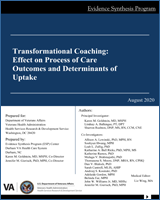This publication is in the public domain and is therefore without copyright. All text from this work may be reprinted freely. Use of these materials should be acknowledged.
NCBI Bookshelf. A service of the National Library of Medicine, National Institutes of Health.
Ballengee LA, Rushton S, Lewinski AA, et al. Transformational Coaching: Effect on Process of Care Outcomes and Determinants of Uptake [Internet]. Washington (DC): Department of Veterans Affairs (US); 2020 Aug.

Transformational Coaching: Effect on Process of Care Outcomes and Determinants of Uptake [Internet].
Show detailsFor full study citations in this appendix, please refer to the report’s main reference list.
- Certainty of evidence
We assessed the certainty of evidence using the Grading of Recommendations Assessment, Development and Evaluation (GRADE) approach36 for 4 domains:
Domain Rating How Assessed Risk of bias Low
Unclear
High
Assessed primarily through study design and aggregate study quality Consistency Not serious inconsistency
Serious inconsistency
Very serious inconsistency
Assessed primarily through whether effect sizes are generally on the same side of “no effect,” the overall range of effect sizes, and statistical measures of heterogeneity Directness Not indirect
Serious indirectness
Very serious indirectness
Assessed by whether the evidence involves direct comparisons or indirect comparisons through use of surrogate outcomes or use of separate bodies of evidence Precision Not serious imprecision
Serious imprecision
Very serious imprecision
Based primarily on the size of the confidence intervals of effect estimates, the optimal information size and considerations of whether the confidence interval crossed a clinical decision threshold Summary certainty of evidence ratings for a body of evidence:
- High—High confidence that the true effect lies close to that of the estimate of the effect.
- Moderate—Moderate confidence in the effect estimate. The true effect is likely to be close to the estimate of the effect, but there is a possibility that it is substantially different.
- Low—Limited confidence in the effect estimate. The true effect may be substantially different from the estimate of the effect.
- Very low—Very little confidence in the effect estimate. The true effect is likely to be substantially different from the estimate of effect.
- Insufficient—Impossible or imprudent to rate. In these situations, a rating of insufficient is assigned.
- CERQual (Confidence in the Evidence from Reviews of Qualitative Research)
We assessed confidence in the evidence from using the Grading of Recommendations Assessment, Development and Evaluation (GRADE) CERQual approach36 ,37 for 4 domains:
Domain Rating How Assessed Methodologi
cal
Limitations
No limitations
Minor limitations,
Moderate limitations,
Significant limitations
The extent to which there are problems in the design or conduct of the primary studies supporting a review finding Relevance No concerns,
Minor concerns,
Moderate concerns,
Significant concerns
The extent to which the body of evidence from the primary studies supporting a review finding is applicable to the context specified in the review question Coherence No concerns,
Minor concerns,
Moderate concerns, Significant concerns
An assessment of how clear and cogent the fit is between the data from the primary studies and the review finding Adequacy No concerns,
Minor concerns,
Moderate concerns,
Significant concerns
The degree of richness and quantity of data supporting a review finding Summary confidence of evidence ratings:
- High confidence: It is highly likely that the review finding is a reasonable representation of the phenomenon of interest
- Moderate confidence: It is likely that the review finding is a reasonable representation of the phenomenon of interest
- Low confidence: It is possible that the review finding is a reasonable representation of the phenomenon of interest
- Very low confidence: It is not clear whether the review finding is a reasonable representation of the phenomenon of interest
- Objective outcomes (ie, non–patient-reported outcomes)
Measures that are not subject to a large degree of individual interpretation and are likely to be reliably measured across patients in a study, by different health care providers, and over time.
- Patient-reported outcomes
Outcomes that are directly reported by the patient without interpretation of the patient’s response by a clinician or anyone else and pertains to the patient’s health, quality of life, or functional status associated with health care or treatment.
- Risk of bias (ROB)
An assessment of study quality. We used the following guidance in this report.
(1) For KQ 1, we used the Cochrane EPOC ROB tool,23 which is applicable to randomized and nonrandomized studies:
- Randomization and allocation concealment
- Comparability of groups at baseline
- Blinded outcomes assessment
- Completeness of follow-up and differential loss to follow-up
- Whether incomplete data were addressed appropriately
- Protection against contamination
- Selective outcomes reporting
- Intervention independent from other changes (specific to interrupted time series)
- Intervention pre-specified (specific to interrupted time series)
- Intervention effect on data collection (specific to interrupted time series)
Summary ROB ratings for a study:
- Low ROB—Bias, if present, is unlikely to alter the results seriously
- Unclear ROB—Bias that raises some doubts about the results
- High ROB—Bias that may alter the results seriously
(2) For KQ 2, we used the Critical Appraisal Skills Programme (CASP) tool26 :
- Validity of study results (clarity of aims, appropriate methodology/design/data collection)
- Nature of the results (ethical consideration, rigorous data analysis, clarity of findings),
- Helpfulness of the results (local value).
No summary ROB was possible for the CASP.
- GLOSSARY - Transformational Coaching: Effect on Process of Care Outcomes and Det...GLOSSARY - Transformational Coaching: Effect on Process of Care Outcomes and Determinants of Uptake
- ThdF, partial [Cronobacter sakazakii]ThdF, partial [Cronobacter sakazakii]gi|190171324|gb|ACE63732.1|Protein
- Rat mRNA homologous to alpha subunit kidney-type Na+,K+ -ATPaseRat mRNA homologous to alpha subunit kidney-type Na+,K+ -ATPasegi|55769|emb|X05883.1|Nucleotide
Your browsing activity is empty.
Activity recording is turned off.
See more...